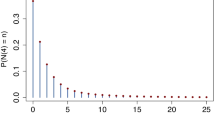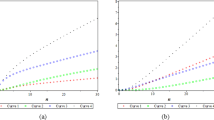Abstract
Among Mixed Poisson processes, counting processes having geometrically distributed increments can be obtained when the mixing random intensity is exponentially distributed. Dealing with shock models and compound counting models whose shocks and claims occur according to such counting processes, we provide various comparison results and aging properties concerning total claim amounts and random lifetimes. Furthermore, the main characteristic distributions and properties of these processes are recalled and proved through a direct approach, as an alternative to those available in the literature. We also provide closed-form expressions for the first-crossing-time problem through monotone nonincreasing boundaries, and numerical estimates of first-crossing-time densities through other suitable boundaries. Finally, we present several applications in seismology, software reliability and other fields.
Similar content being viewed by others
References
Albrecht P (2006) Mixed poisson process. In: Encyclopedia of Statistical Sciences. Wiley
Aven T, Jensen U (1999) Stochastic models in reliability. Applications of mathematics (new york) 41. Springer, New York
Barlow RE, Proschan F (1981) Statistical theory of reliability and life testing to begin with. MD, Silver Spring
Bastos Martini MR, Kanoun K, Moreira de Souza JM (1990) Software reliability evaluation of the TROPICO - r switching system. IEEE Trans Reliab 39:369–379
Benson DA, Schumer R, Meerschaert MM (2007) Recurrence of extreme events with power-law interarrival times. Geophys Res Lett 34:L16404. https://doi.org/10.1029/2007GL030767
Belzunce F, Ortega EM, Pellerey F, Ruiz JM (2006) Variability of total claim amounts under dependence between claims severity and number of events. Insurance Math Econ 38:460–468
Cai H, Eun DY (2009) Crossing over the bounded domain: from exponential to power-law intermeeting time in mobile ad hoc networks. IEEE/ACM Trans Netw 17:1578–1591
Cha JH (2014) Characterization of the generalized pólya process and its applications. Adv Appl Prob 46:1148–1171
Cha JH, Finkelstein M (2013) A note on the class of geometric counting processes. Prob Engin Inform Sci 27:177–185
Cha JH, Finkelstein M (2018) On information-based residual lifetime in survival models with delayed failures. Stat Prob Lett 137:209–216
Cha JH, Giorgio M (2016) On a class of multivariate counting processes. Adv Appl Prob 48:443–462
Clegg RG, Di Cairano-Gilfedder C, Shi Z (2010) A critical look at power law modelling of the Internet. Comput Commun 33:259–268
Di Crescenzo A (1999) A probabilistic analogue of the mean value theorem and its applications to reliability theory. J Appl Prob 36:706–719
Di Crescenzo A, Martinucci B, Zacks S (2015) Compound Poisson process with a Poisson subordinator. J Appl Prob 52:360–374
Esary JD, Marshall AW, Proschan F (1973) Shock models and wear processes. Ann Probab 1:627–649
Fernández-Ponce JM, Ortega EM, Pellerey F (2008) Convex comparisons for random sums in random environments and applications. Prob Engin Inform Sci 22:389–413
Finkelstein M (2010) A note on converging geometric-type processes. J Appl Probab 47:601–607
Gordon J (1995) Pareto process as a model of self-similar packet traffic. In: Proceedings of GLOBECOM 1995, 2232-2236, Singapore, p 1995
Grandell J (1997) Mixed Poisson processes. Monographs on statistics and applied probability, vol 77. Chapman & Hall, London
Joag-Dev K, Kochar S, Proschan F (1995) A general composition theorem and its applications to certain partial orderings of distributions. Stat Prob Lett 22:111–119
Kanoun K, Bastos Martini MR, Moreira de Souza J (1991) A method for software reliability analysis and prediction application to the TROPICO-r switching system. IEEE Trans Software Engin 17:334–344
Karlin S (1968) Total positivity, vol 1. Stanford University Press, Stanford
Kozubowski TJ, Podgórski K (2009) Distributional properties of the negative binomial lévy process. Probab Math Statist 29:43–71
Lam Y (2007) The geometric process and its applications world scientific. Hackensack, NJ
Lavergnat J, Golé P (1998) A stochastic raindrop time distribution model. J Appl Meterology 37:805–818
Lyu MR (1996) Handbook of software reliability engineering. McGraw-Hill Inc., Hightstown
McFadden JA (1965) The mixed Poisson process. Sankhy\(\bar {\mathrm {a}}\) A 27:83–92
Paxson V, Floyd S (1995) Wide area trdfie: the failure of Poisson modeling. IEEE/ACM Trans Netw 3:226–244
Pellerey F (1993) Orderings under cumulative damage shock models. Adv Appl Prob 25:939–946
Pradhan B, Kundu D (2016) A choice between poisson and geometric distributions. J Indian Soc Probab Stat 17:111–123
Rolski T, Schmidli H, Schmidt V, Teugels J (1999) Stochastic processes for insurance and finance. Wiley, Chichester
Shaked M, Shanthikumar JG (1988) Stochastic convexity and its applications. Adv Appl Probab 20:427–446
Shaked M, Shanthikumar JG (2007) Stochastic orders. Springer, New York
Singh H, Jain K (1989) Preservation of some partial orderings under Poisson shock models. Adv Appl Prob 21:713–716
Sreehari M, Vasudeva R (2012) Characterizations of multivariate geometric distributions in terms of conditional distributions. Metrika 75:271–286
Acknowledgements
We thank two anonymous referees for their useful comments that improved the paper. This research is partially supported by the groups GNAMPA and GNCS of INdAM.
Author information
Authors and Affiliations
Corresponding author
Additional information
This paper is dedicated to the cherished memory of Moshe Shaked, to whom we are very grateful for much inspiration and advice on our studies in stochastic orderings and stochastic processes.
Appendix: Proof of Proposition 2.2
Appendix: Proof of Proposition 2.2
Fix \(\textbf {t}=(t_{1},t_{2},\ldots ,t_{m}) \in \mathcal {T}^{+}_{m}\). From Eq. 7 we have
Recall now that, for \(\textbf {k}=(k_{1},k_{2}, \ldots ,k_{m}) \in \mathcal {A}\),
and observe that it holds
if and only if the term t1t2⋯tm appears in expansion of the product \(t_{1}^{k_{1}} (t_{2}-t_{1})^{k_{2}} \cdots (t_{m}-t_{m-1})^{k_{m}}\). With a straightforward computation of such product, and considering the constraints in Eq. 8, it is easy to see that the condition
is fulfilled if and only if k1 + k2 + … + km = m − 1. Recalling that it should be k1 = 0, and again considering the constrains (8), we have that Eq. 40 holds if, and only if, k1 = 0 and ki = 1 for all i = 2, 3,…,m. In this case we have
In conclusion, from Eqs. 38, 39 and 41, for 0 < t1 < t2 < … < tm we have
while the density is zero whenever \(\textbf {t} \not \in \mathcal {T}^{+}_{m}\). Finally, this gives (9).
Rights and permissions
About this article
Cite this article
Di Crescenzo, A., Pellerey, F. Some Results and Applications of Geometric Counting Processes. Methodol Comput Appl Probab 21, 203–233 (2019). https://doi.org/10.1007/s11009-018-9649-9
Received:
Revised:
Accepted:
Published:
Issue Date:
DOI: https://doi.org/10.1007/s11009-018-9649-9
Keywords
- Counting processes
- Multivariate geometric distribution
- First-crossing time
- Shock models
- Stochastic orders
- Aging




